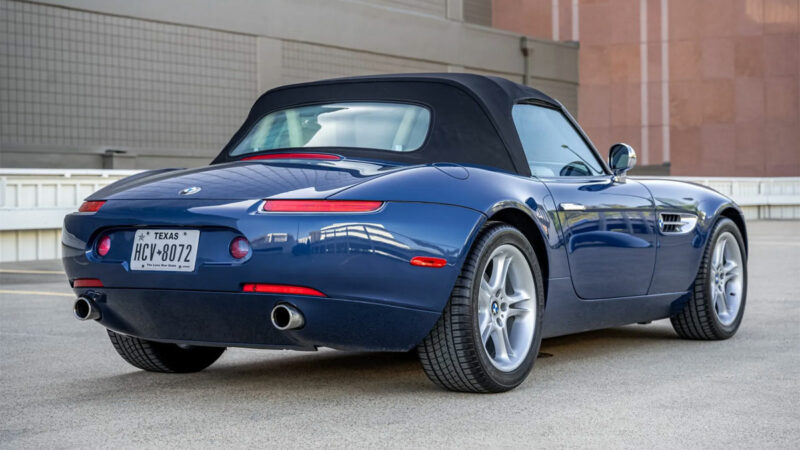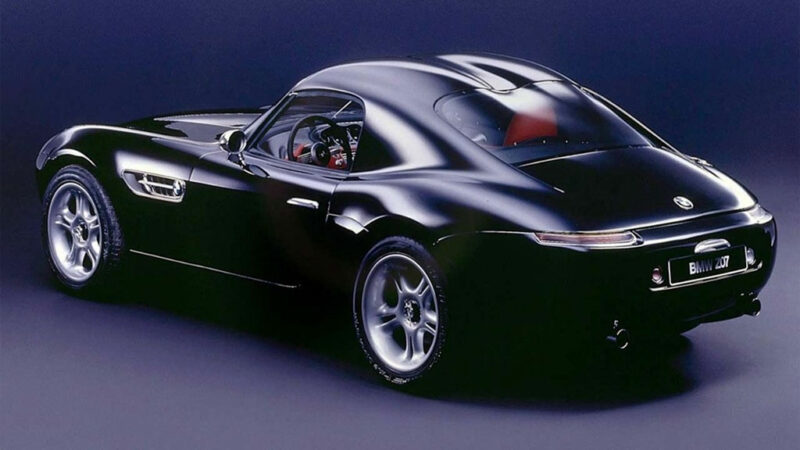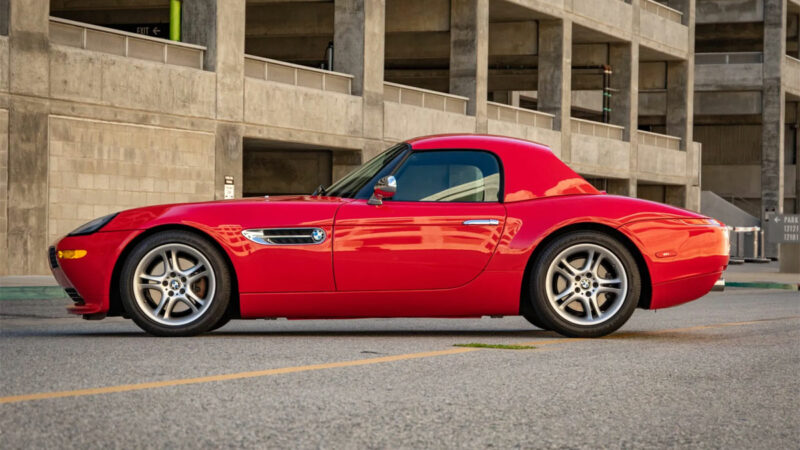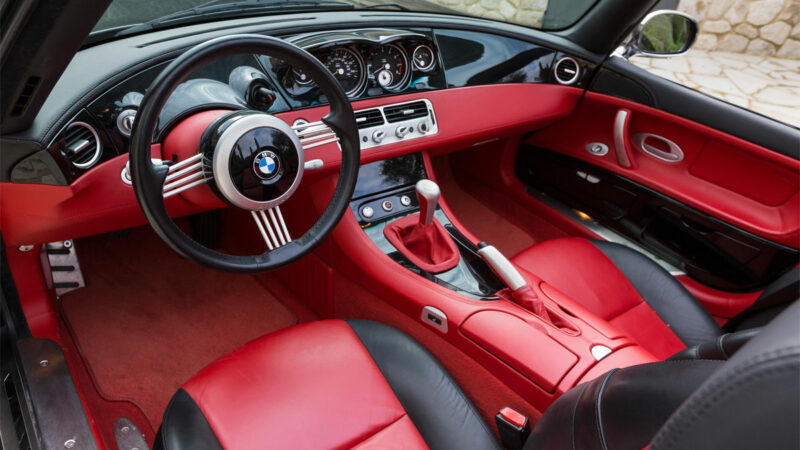With its sleek, retro-inspired design, the BMW Z8 captured the classic roadster charm of the 50s while delivering modern performance.
It was aimed at evoking the classic appeal of the 1950s BMW 507, and, thanks to the design team led by Chris Bangle and Henrik Fisker (who’d go on to become head of design at Aston Martin and found/CEO of Fisker cars), the Z8 certainly achieved its goal.
The development of the BMW Z8 took place under the codename “E52” between 1993 and 1999. On the outside, the sleek, retro lines were carefully penned by Fisker, while the interior was handled by Scott Lempert.
See Also – The History of the BMW M Coupe
The Z8 brought BMW’s roadster legacy into the contemporary era. Its long hood and short rear deck channeled vintage sports cars, while the potent V8 engine and six-speed manual transmission delivered an exhilarating ride. The aluminum space frame construction and perfect 50/50 weight distribution meant the Z8 could also handle curves as well as straightaways.
- Known for: Beautiful, nostalgic “long hood” design, potent V8 power, and 50/50 weight distribution.
- First Model Year: 2000
- Final Model Year: 2003
- Original Price in 1992: $128,000 (around $235k USD today)
- Total Sold in the US: 2,543 [source]
What Does “Z8” Stand For?

The “Z” nomenclature had become well-established in BMW’s model lineup designating their sporty roadster offerings. Debuting first in the late 1980s with the Z1, the Z prefix marked BMW’s move into more aggressively styled, performance-oriented two-seater convertibles. The 1991 Z3 further developed this concept and was a strong seller.
As the 8th such distinct model series following the Z1’s launch, the Z8 slotted into BMW’s road map as the new halo sports car of the family. The number 8 signified flagship status and a clean-sheet approach to design and engineering that set the Z8 apart from predecessors like the Z3.
While still an evolution of BMW’s roadster traditions, the Z8 represented a bolder, more focused dedication to premium driving performance in an open-top package.
The name Z8 fit with the car’s unique retro-roadster image that channeled past legends while still delivering a modern take on power and handling. More of a luxury cruiser than the smaller Z3, the Z8 created a new niche for BMW that fused heritage style with raw capability.
See Also – History of the Dodge Viper
The Z07 Concept

The beginning of the Z8 traces back to BMW’s Z07 concept car. Unveiled at the 1997 Tokyo Motor Show, this stunning prototype was an instant sensation, garnering significant attention from the automotive world.
Keeping the long hood, short rear deck proportions of its 50’s predecessors, the two-seat Z07 concept featured retro styling cues like its large front kidney grille and gills/vents directly behind the wheel arches.
The show car generated significant excitement and positive feedback, prompting BMW leadership to approve putting an updated version into production, although still at low volumes befitting a specialty model.
The Z07’s breathtaking lines and extroverted styling left a lasting impression. It sparked nostalgia while pushing boundaries, laying the groundwork for the production Z8 to capture that excitement with real-world performance.
Read Also – History of the Mazda RX-7
BMW Z8 Generations
1st Generation – E52 (1999-2003)

The first and only generation of the BMW Z8, the E52, is a roadster that was produced between 1999 and 2003. This generation was inspired by the classic BMW 507, which can be seen in the Z8’s design elements, such as the side vents and the long hood. BMW’s own press release called the Z8 “romantically curvaceous”.
Under the hood of the E52, a powerful 4.9-liter M62 V8 engine generates an impressive 395 hp and 369 lb-ft of torque. The engine technology is equipped with double VANOS, a variable valve timing system exclusive to BMW.
This V8 engine is mated to a six-speed manual transmission, which sends power to the rear wheels. As a result, you’ll experience smooth, powerful driving dynamics with the Z8.
The suspension system of the BMW Z8 is an engineering marvel that ensures your handling is optimized. The 50/50 weight distribution optimizes the vehicle’s balance, contributing to a smooth and stable ride. The chassis, crafted from aluminum, adds to the vehicle’s agility and performance while also helping reduce overall weight for better fuel efficiency.
Jumping inside the BMW Z8, you’ll be greeted by a retro-inspired interior with a luxurious touch. The gauges and instrumentation are meticulously arranged, giving you an intuitive driving experience. Additionally, the use of high-quality materials like aluminum and leather amplifies the vehicle’s premium and sporty feel.
In the end, a total of 5,703 BMW Z8 were produced with 2,543 of them making it stateside (while the majority remained in Europe).
See Also – History of the Pontiac Fiero
Z8… BMW Z8.
From time to time, you come across cars that leave an indelible mark on popular culture. One such vehicle is the BMW Z8. Perhaps its most memorable cameo was in the James Bond film The World Is Not Enough starring Pierce Brosnan as 007.
The car’s involvement in the film was announced in July, 1999, ten months before the Z8s went on sale to the public. Turns out there were a variety of Z8s used during the filming.
BMW supplied 3 hand-built Z8 prototypes which were used in the scenes where 007 is seen driving the car. Apparently they sent along BMW engineers to oversee their use and they guarded them 24 hours/day.
Special effects supervisor Chris Corbould built 3 replicas using Cobra kit-car chassis and fiberglass bodies. Grilles, wheels, chrome, lights and badging were supplied by BMW.
The replicas were powered by 5.7-litre Chevy engines bolted to Tremec 5-speeds, and used Jaguar rear ends. Because the Jag used inboard brakes, fake discs had to mounted outboard to preserve the Z8’s stock appearance. One of these cars, sans drive-train, was sawed in half for a scene in the movie.
They also built a 1/4 scale radio controlled model of the Z8 which was used in some of the scenes. The film makers defy anyone to tell the model from the real thing!
The Alpina Roadster

Although already a limited production flagship model, the Z8 chassis and powertrain lent itself to further refinement by noted BMW tuner Alpina. Founded in the 1960s and working closely with BMW for decades, Alpina took the standard European-spec Z8 coupe introduced in 2000 and enhanced nearly every aspect of its performance for the ultimate driving experience.
Under the hood, the Alpina Roadster V8 was powered by a 4.8-liter engine that produced 375 hp and 383 lb-ft of torque. This engine deviated from the standard Z8’s 4.9-liter V8 found in the M5 but still packed a serious punch.
In fact, Alpina’s tuning expertise contributed to the more significant torque numbers in the V8 Roadster, providing drivers with an exhilarating experience on the open road.
Performance-wise, the Alpina Roadster V8 boasted a top speed of nearly 166 mph, making it a force to be reckoned with on both highways and winding country roads. Additionally, the fine-tuned suspension and refined engineering provided a smooth, comfortable ride characteristic of a luxury grand tourer.
Only 555 Alpina V8 roadsters were ever produced, making it a highly sought-after collector’s item today (even more so that the already coveted Z8).
Why Was the BMW Z8 Discontinued?

The rather short production run of the Z8 was intentional from the start rather than reflecting fading popularity or external factors leading to its demise. As BMW’s technology showcase halo roadster of the era, the business case for the Z8 justified the development costs and manufacturing complexity required for the low-volume model.
BMW determined the level of demand for a retro-style luxury roadster priced around $130,000 could support targeted sales of between 3,000 to 5,000 units globally. Reaching over 5,700 units produced by 2003, the Z8 exceeded objectives.
Additional factors contributing to ending Z8 production as planned included:
- Overlap with the new BMW Z4 roadster launching in 2002 covering a lower market segment
- Significant resource requirements for the Z8’s hand-built production method
- Desire to shift focus to newer concepts being explored for future BMW models
Rather than declining popularity, the Z8 accomplished what it set out to do for enhancing BMW’s brand reputation and showcasing innovation. When its production mandate ended after the 2003 model year, the Z8 departed having made its mark as a classic BMW roadster for the early 2000s era.
So while the BMW Z8 may have been a beautiful and powerful roadster that captured the hearts of collectors, it simply wasn’t a sustainable model for the company. Its high price, limited production, and evolving automotive landscape all contributed to its discontinuation.
Read Also – Why Was the Toyota MR2 Discontinued?
Common Problems With the BMW Z8
As an extremely low production sports car built to exacting standards, the Z8 avoided most of the typical reliability issues or endemic flaws seen affecting higher volume BMW models. Meticulous hand-assembled construction yielded solid durability for the Z8’s essential components like the engine and transmission.
However, the limited run does present current Z8 owners challenges in locating replacement parts when maintenance is required. As an older niche model without large parts inventory still stocked at dealerships, securing items like custom interior trim and body panels can be difficult if needed following damage. Electronics can also be tricky to service on older Z8s as components reach obsolescence.
Perhaps the most vulnerable aspect of Z8 ownership is the soft convertible top, though common to most aging roadsters. Checking for proper operation of the power-folding top mechanism and signs of wear in the weather sealing and plastic windows will help new owners prioritize any needed refurbishment.
Aside from higher restoration costs tied to its rarity and uniqueness, lack of factory support, the Z8 has demonstrated impressive longevity thanks to the care taken in its original construction.
For most owners, priority is preserving these future collectibles rather than racking up high mileage. Thanks to low volumes, each Z8 has good prospects for becoming more valuable over time.
Featured Image: 2002 BMW Z8 in Titanium Silver (Bonhams)
- History of the Chevrolet SSR: The Retro-Styled Convertible Pickup - Apr 25, 2024
- The History of the BMW M Coupe (the “Clown Shoe”) - Mar 26, 2024
- The History of the Ford Flex - Feb 28, 2024

